Link Building Outreach: A Guide for Beginners
If you want to grow your organic search rankings, then earning more backlinks is the fastest and most effective way to do it. However, earning backlinks the […]
If you want to grow your organic search rankings, then earning more backlinks is the fastest and most effective way to do it. However, earning backlinks the right way requires webmasters to do the work of link building outreach.
Link building outreach can help you secure backlinks from relevant, authoritative publications. It’s also a Google-compliant way of earning backlinks and can help you grow your site authority faster and for free.
This article will outline how to do link building outreach in the right way to earn backlinks safely. All of the strategies outlined below leverage original content in the outreach process, helping you provide value to users, search engines, and your website.
What is Link Building Outreach?
Link building outreach is the process of reaching out to webmasters, publishers, and journalists in an effort to earn backlinks to your website.
Manual outreach is an important part of an SEO strategy, as earning new backlinks is one of the best ways to improve a website’s SERP visibility.
But outreach can be time-consuming and can produce very few results if not carried out strategically. Choosing the right outreach targets and pitching the right content is key to getting better results with link building campaigns.
Some Background on Link Building
If you’re a beginner SEO, you’ve likely already discovered that earning backlinks is hard work.
Because over the years, black hat SEOs have deployed questionable backlink strategies to elevate their SERP performance, even when their web pages were not high-quality or relevant to users’ search queries.
So Google has refined their algorithm to crack down on any webmaster that appears to be participating in unethical linking. This has made some webmasters hesitant to pursue link building of any kind in fear of being penalized.
But link building can be done safely!
How? By leveraging original content and manual outreach.
Is Link Building Worth the Time and Effort?

A little link equity can go a long way, particularly for new websites.
The benefits of link building outreach to SEO performance are significant. Here’s why:
- Backlinks are Google’s #1 ranking factor. The more high-quality backlinks your website has, the greater your site authority and the overall ranking potential of web pages
- Unique Referring Domains are also an important ranking factor. Every additional link you get from the same domain decreases in link equity. So the more unique websites in your backlink profile, the more Google will see your website as reputable and trustworthy in your industry.
- In addition to SEO, backlinks send referral traffic to your web pages. That means more eyes seeing the products, services, or content that your business offers.
- Outreach can lead to valuable partnerships. In addition to backlinks, outreach can bring benefits to other areas of your digital marketing, like public relations, social media, and influencer partnerships.
- Anchor Text Shows Relevance: The anchor text of your backlinks communicates to Google crawlers what your content is about. It also helps crawlers determine what kind of keywords to promote your pages for in the SERPs.
So is link building outreach worth it? That’s an overwhelming yes.
If you don’t yet have a team member doing link building outreach on behalf of your website, or if you haven’t outsourced your outreach to a reputable SEO agency, it’s time to get to work.
Getting Started with Link Building Outreach
Over the past ten years in the SEO industry, I’ve seen all sorts of creative ways that SEO and marketing teams have earned backlinks to their websites.
However, the most successful and scalable strategies always took a targeted approach. Although you can do general outreach on behalf of your domain, leveraging individual, high-quality pieces of content is often more impactful.
Why? Because it provides your outreach targets with the exact content they are seeking.
So here’s how to get started with impactful, targeted outreach campaigns.
First, use the right SEO tools
Efficient and strategic link building outreach cannot be executed without access to the right SEO tools.
You’ll want to have the following technologies to do your outreach:
- A Backlink Analyzer: This will allow you to see the backlinks and referring domains of your own website as well as your competitors’.
- Competitor Analysis Software: The best competitor analysis tools will help you understand what pages on your competitors’ websites are performing best and earning the most link equity.
- Content Research Tools: These types of tools help you see what type of content others in your industry are creating and what is performing best across digital channels.
There are many options available, but I suggest an enterprise SEO software platform like Search Atlas that contains all of these SEO tools within a single dashboard.
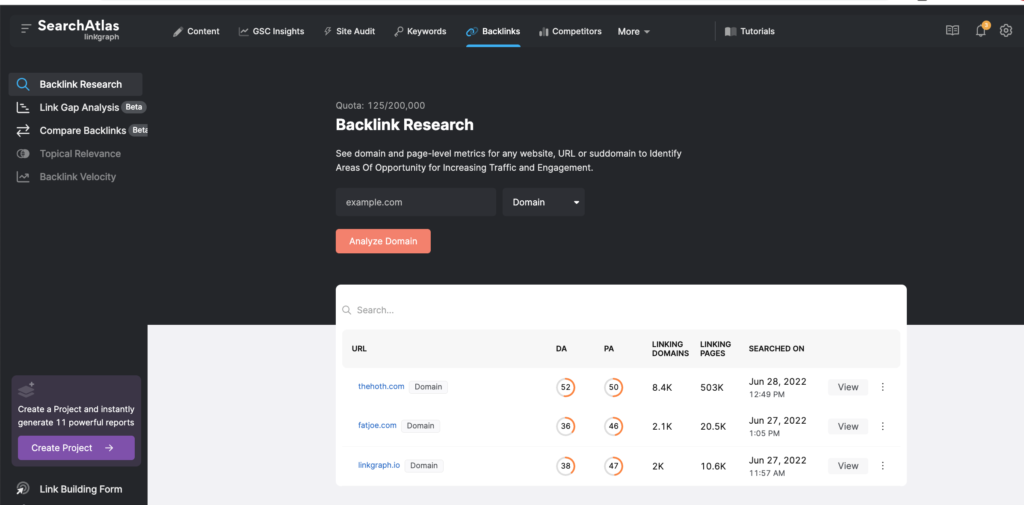
Second, look to your competitor’s top performing content
Any content used for link building outreach needs to be both relevant to your target keywords, but also to the target audience of the linking domain.
But if you don’t know what type of content to use for your outreach, backlink research tools allow you to spy on your competitors to see which content on their website is earning the most link equity.
For example, I can use a backlink researcher to identify which of my competitor’s web pages has the most backlinks.
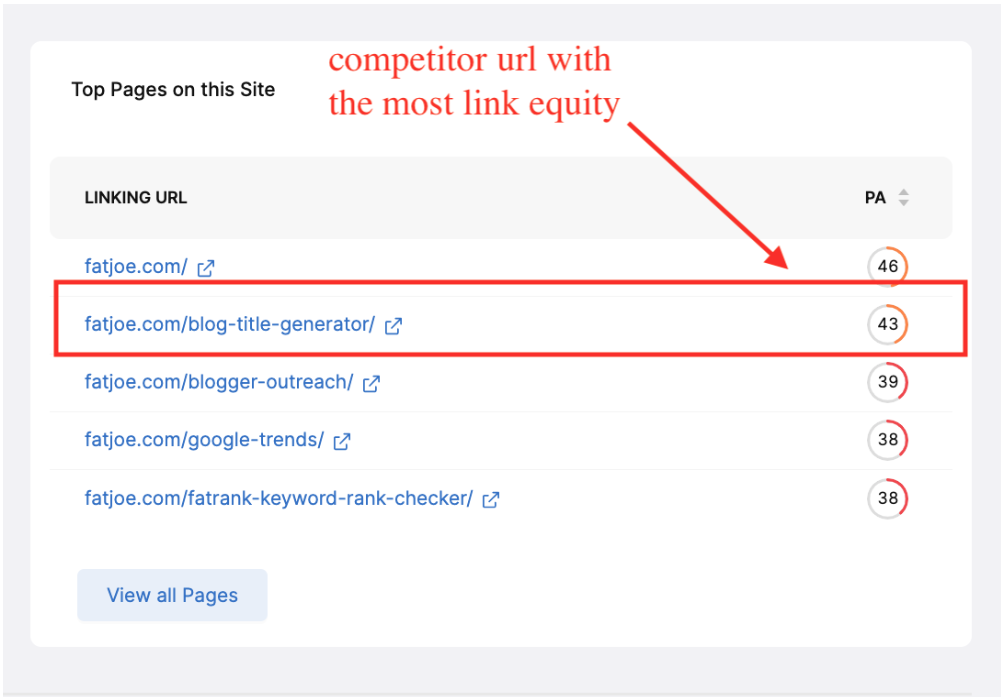
I can also see that page earns the most organic keywords and clicks from search.

Now that I know this content is helping my competitors earn backlinks, I may want to consider creating a similar piece of content on my own website.
If you already have high-quality content on your website that is worthy of links, then you don’t necessarily need to start at this step.
However, seeing what content is performing well for your competitors can help you get more ideas for your SEO content calendar.
Third, create high-quality content that is worthy of links
When it comes to creating helpful, high-quality content for outreach campaigns, keep in mind that no one will want to link to a web page that has thin content, irrelevant text, slow-load times, or spammy links.
High-quality content is the foundation of all successful outreach. You want to be able to convince the journalists, webmasters, or publishers that you’re reaching out to that your content is worthy of a link.
Or, convince them that your content is better or more-up-to-date than the content they are currently linking to.
For example, after my content team discovered the top-performing pages of our competitors outlined above, we looked at their content more closely to see why it was earning links.
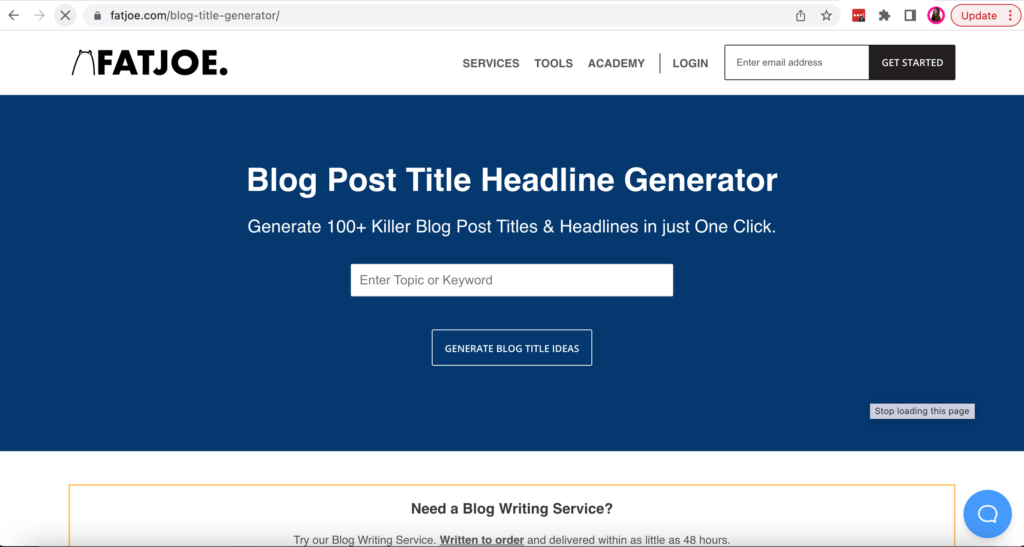
Then, we did our best to create an even better piece of content on our own domain with our own unique spin.
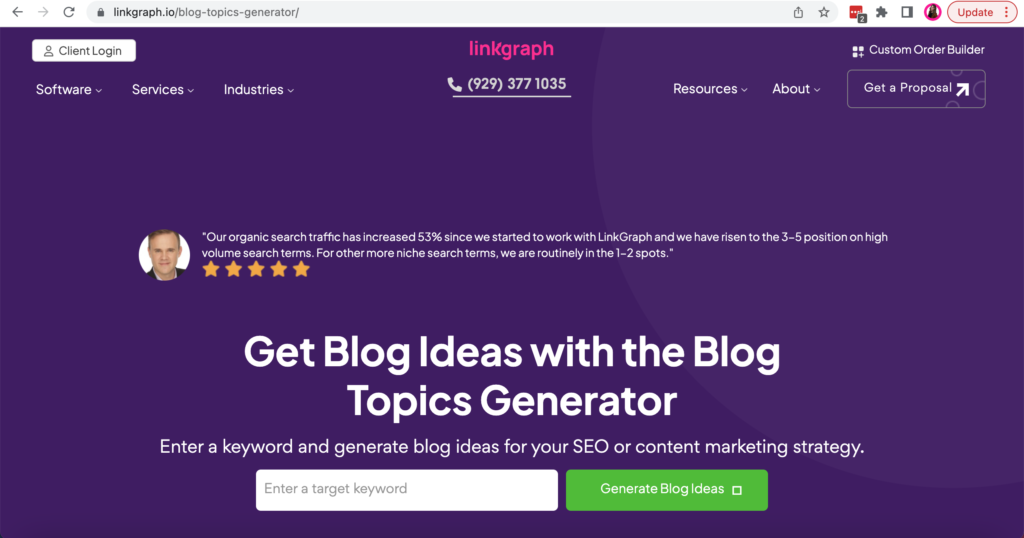
If you don’t have team members who can help you create valuable content, consider outsourcing to an agency that specializes in content writing services.
Fourth, put together a list of outreach targets
The next step in the process is identifying potential publication targets for your link building outreach.
Remember, Google wants to see that your website keeps company with other high-quality websites. Links from spammy, low-quality, or irrelevant websites are not worth reaching out to.
Here are some quality indicators to look for when choosing outreach targets:
- Domain Authority: Websites with low Domain Authority may signal low-quality content. If you are trying to do link building outreach to grow your own DA, then you should aim for publication targets that have equal to or higher DA scores than your own.
- Organic Traffic: Websites with strong organic traffic are a good signal that Google also sees that website as authoritative and its content as high-quality
- Industry/Topical Relevance: In general, backlinks from relevant websites help communicate to Google that your website has topical relevance to a specific topic area or industry niche
You can use the backlink analyzer tool in Search Atlas to see what websites are linking to your competitors and add those publications to your outreach list.
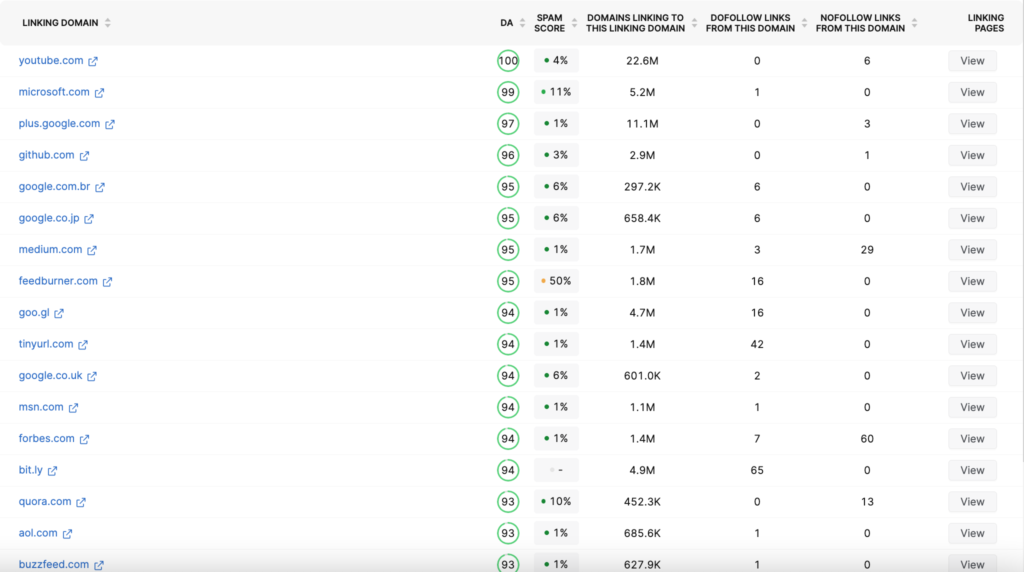
Fifth, draft a compelling pitch
Like with any public relations, sales, or marketing outreach, tailored, specific messaging is more likely to produce better results.
You can send out a generic email, but it’s better if you show in your pitch that you understand the outreach target’s industry, audience, and existing content.
Here’s an example of what a targeted pitch might look like:
Hey there! I came across your helpful article on writing SEO-friendly blog content. Great work! At LinkGraph, we have a free blog topic generator that allows users to generate blog titles with just 1-click. I think your readers would find it helpful. Would you consider mentioning it in your article? I’m biased, but I think it’s a really useful tool for SEO content creators. If you try out the tool for your own content calendar, please let me know what you think! Manick
Make sure to include links to the valuable content you want the outreach target to link to. That way, they can easily review it for themselves to see if they find it valuable.
Sixth, find email address of your outreach targets
Once you have your target publications, you want to send your pitch to the right person.
Here are some platforms that will come in handy during this process:
- Masthead/About Section: Often, publications will have a section on their website that identifies their editorial or content staff and how to reach out to them
- Muckrack: For finding emails of specific journalists, MuckRack is a database that can help you find contact emails
- Twitter: Many content managers include their email addresses in their Twitter bios so potential partners can reach out to them more easily.
- LinkedIn: Search for employees at a particular business. Look for job titles like, “Content Manager,” “Editorial,” or “Content Strategist.” These are likely the people making decisions about content and links on your target publication.
Last but not least, let those pitches fly!
Once you completed the above steps, it’s time to send those pitches off.
Not everyone will respond to you, and that’s okay. But if your content, pitch, and target publication align, you’ll likely see this outreach result in some high-quality backlinks.
You can repeat steps 4-6 as many times as needed and for any piece of high-quality content that lives permanently on your website.
4 Link Building Outreach Strategies to Try Right Now
The below strategies are great because they also leverage original content to earn backlinks, but the outreach process for each is distinct.
Also, they are considered Google-compliant, as they bring true value to users, which is what Google cares about most. Consider adding them to your link building efforts!
1. Haro Link Building
HARO, or Help-A-Reporter-Out, is a free service from Cision that helps simplify the outreach process. The platform connects webmasters directly with the journalists and publishers looking for expert commentary and high-quality content like theirs.
This is currently one of my favorite outreach strategies because it can help you acquire backlinks from authoritative publications that are otherwise very difficult to acquire.
When responding to a HARO request with expert commentary, draft your pitch so the journalist can simply copy and paste your response directly into their article. When promoting a specific piece of content in a HARO response, make sure you provide a tailored response based on the original HARO request.
For example, the below HARO response was crafted in response to the question: What will be the most important SEO trend in 2021?
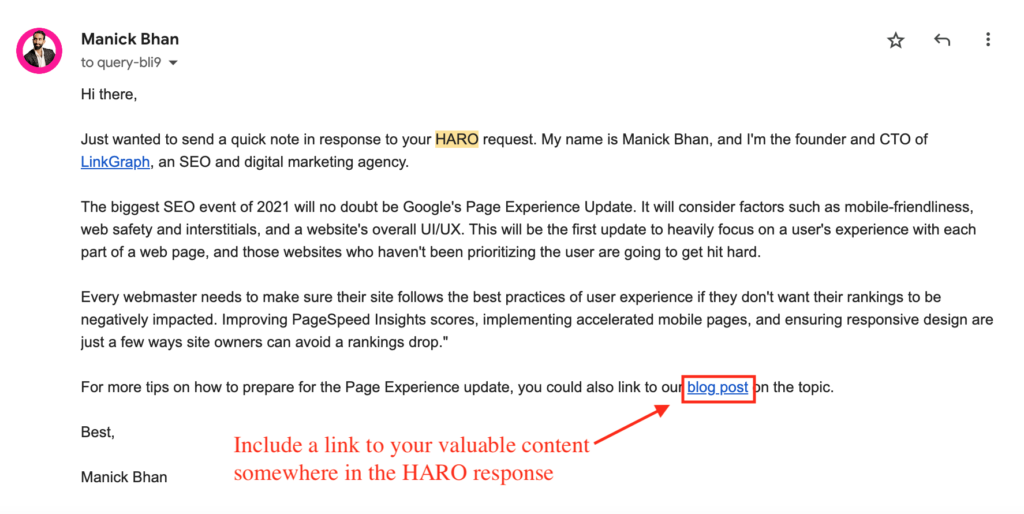
To get started with HARO, sign up for the service and select the industry areas that have the most relevance to your business.
You will receive HARO requests three times a day and should monitor those emails for relevant link building opportunities.
2. Influencer Outreach
Before your content can earn backlinks, it has to be seen.
Influencer outreach is another impactful link building outreach strategy because it can help you get more eyes on your content and subsequently, more backlinks.
When an influencer agrees to feature coverage of or links to your content, you are able to access the audience they have already worked hard to build.
By targeting influencers who have strong relevance to your products or services, you are likely gaining access to a very qualified audience. For example, this digital marketing influencer reviews the top marketing software and would be a potential outreach target for companies with a digital marketing software product.
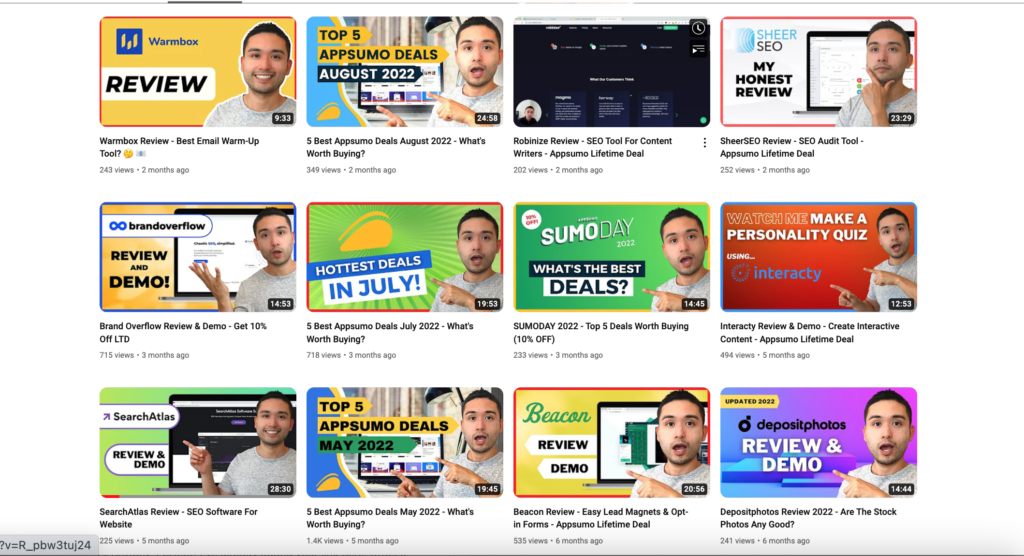
Sometimes, earning more backlinks is simply about getting more eyes on your content.
For newer websites that can’t yet leverage page-1 rankings or an existing following on social media platforms, reaching out to influencers can be a great way to start building off-site SEO signals.
3. Digital PR
Digital PR is all about combining the power of several strategies including content marketing, social media, and public relations, for the purpose of earning backlinks.
Often a more creative approach to link building, digital PR will leverage content like maps, tools, original research, or data, to capture the interest of high DA publications with wider audiences.
This often means creating a very specific piece of content that has a wider mass appeal and isn’t necessarily promoting your products or services directly.
For example, last Fall, Zippia, a job search platform, used Google Search Console keyword data to create this map of the most popular thanksgiving sides by state.

This piece of content earned over 250+ backlinks, some of which came from very authoritative domains.
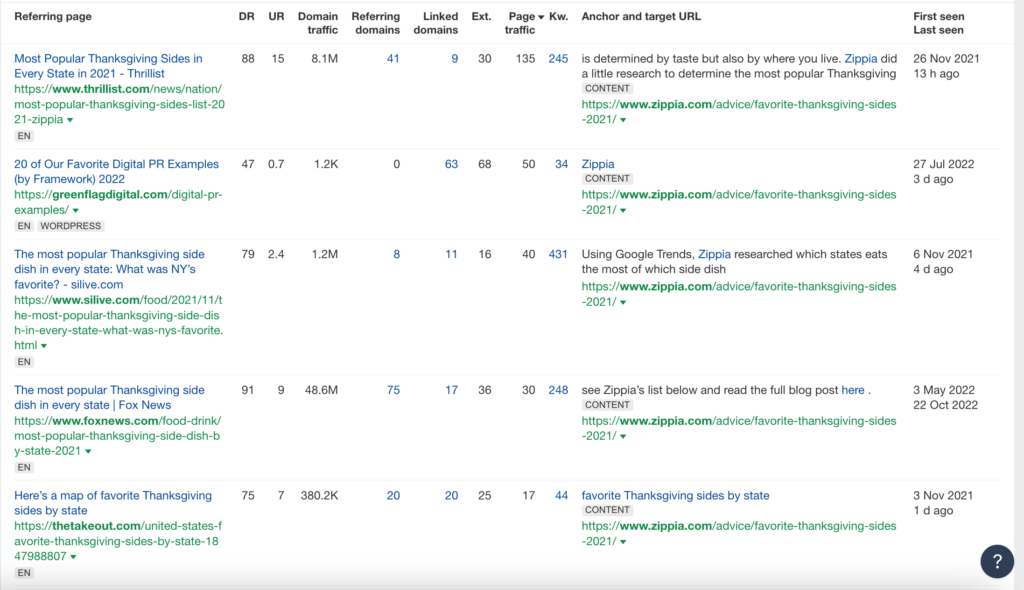
It’s important that if you do utilize this strategy, make sure that your content is actually relevant to your areas of expertise. With Google’s Helpful Content update, Google only wants to rank content from a domain that fits within their primary topic areas.
So get your creativity to work and see what fun and valuable types of content you can leverage through digital PR.
4. Guest Blogging
Instead of leveraging the content on your website, you can also create content for other webmasters that brings value to their target audiences. This is called guest blogging or guest posting, and its a tried-and-tested link building strategy that has been utilized by many content marketers.
Once you secure a guest post opportunity, you can include links in the content that point back to relevant pages on your own website.
Webmasters are always on the lookout for good content. By creating that content for them and for free, you provide value to their growth strategy as well as your own. If your content performs well for the other webmaster, they may ask you to contribute regularly to their content calendar.
Manual outreach to secure guest blogging is a little different than leveraging existing content on your website. You’ll want to consider mentioning the following in your pitch:
- An explanation of why you are an expert in the publication’s industry or niche
- Other relevant publications you have written for to establish author authority (plus links to guest posts you’ve written before)
- Example titles of guest posts that you could write for the publication
- Enthusiasm for bringing value to their target audience!
Most reputable publications do have some restrictions on what backlinks you can include to prevent their contributors from engaging in any questionable linking practices. Some may limit links to a specific number. Others may limit links to a type of page, like a blog or resource page.
Make sure that you respect the publication’s guidelines. Also, aim for target publications that have dofollow backlinks rather than nofollow. Otherwise, there will be no link equity passed along to your web page.
Conclusion
The more content that you publish on your website, the more often that you can repeat the link building outreach process over and over again.
Having a team member or agency consistently promoting your content can mean a steady stream of backlinks, and DA growth, for your domain.
It’s okay to start small with outreach and utilize the resources you currently have.
Then, when you’re ready, the above processes can be easily scaled up when you have the team, and content, to do it.














































































